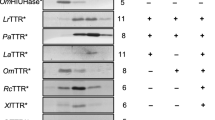Abstract
Thyroxine-binding globulin (TBG), transthyretin (TTR), albumin (HSA), plus other plasmatic proteins, which include apolipoproteins, can bind and transport thyroid hormones (TH). In 1994, a 5-residue motif (Y, L/I/M, X, X, V/L/I) conserved in human TBG, TTR, HSA, and human and animal apolipoproteins was identified. Recently, we noticed that a number of residues upstream and downstream that motif are also conserved.
We tested in silico the conservation of this larger motif in the many additional animal sequences of TH plasma carriers discovered after 1994. To this aim, we searched for the occurrence of the “new” motif in human and animal apolipoprotein and non-apolipoprotein TH-binding plasmatic proteins, and in a group of randomly selected proteins (2918 sequences from 56 species) not known as TH binders.
Our results confirm the conservation of the “new” motif, associated with TH binding, in a total of 426 sequences analyzed (220 belonging to 169 apolipoproteins from 69 species, 206 belonging to 123 nonapolipoproteins from 54 species). Additionally, we found that within such conserved segments some differences between groups of TH plasma carriers exist. Interestingly, number and type of differences appear related to the affinity of each carrier for thyroid hormones. No occurrence of the motif was found in control proteins (alpha- and beta-tubulin, eosinophil cationic protein, endothelin-1, -2 and -3, IgG receptor, tropomyosin, Wnt inhibitory factor 1, erythropoietin, insulin and haptoglobin).
Maintenance of a TH-binding domain in apolipoproteins throughout the phylum should be not less important that maintenance of the lipid binding domain.



Similar content being viewed by others
References
Benvenga S. Thyroid hormone transport proteins and the physiology of hormone binding. In: LE B, DS C, editors. Werner and Ingbar’s The Thyroid: a clinical and fundamental text. 10th ed. Philadelphia: Wolters Kluwer, Lippincott Williams & Wilkins; 2013. p. 93–103.
Sousa MM, Berglund L, Saraiva MJ. Transthyretin in high density lipoproteins: association with apolipoprotein A-I. J Lipid Res. 2000;41:58–65.
Benvenga S, Lapa D, Trimarchi F. Thyroxine binding to members and non-members of the serine protease inhibitor family. J Endocrinol Investig. 2002;25:32–8.
Leppendinger G. Amphibian choroid plexus lipocalin, Cp11. Biochim Biophys Acta. 2000;1482:119–26.
Wasan KM, Ramaswamy M, Ng SP, Wong W, Parrott SC, Ojwang JO, Wallace T, Cossum PA. Differences in the lipoprotein distribution of free and liposome-associated all-trans-retinoic acid in human, dog, and rat plasma are due to variations in lipoprotein lipid and protein content. Antimicrob Agents Chemother. 1998;42:1646–53.
Jerabeck I, Zechmeister-Machhart M, Binder BR, Geiger M. Binding of retinoic acid by the inhibitory protein C inhibitor. Eur J Biochem. 2001;268:5989–96.
Benvenga S, Cahnmann HJ, Robbins J. The thyroxine-binding site of human apolipoprotein-A-I: location in the N-terminal domain. Endocrinology. 1991;128:547–52.
Benvenga S, Cahnmann HJ, Robbins J. Characterization of thyroid hormone binding to apolipoprotein-E: localization of the binding site in the exon 3-coded domain. Endocrinology. 1993;133:1300–5.
Benvenga S, Cahnmann HJ, Rader D, Kindt M, Facchiano A, Robbins J. Thyroid hormone binding to isolated human apolipoproteins A-II, C-I, C-II, and C-III: homology in thyroxine binding sites. Thyroid. 1994;4:261–7.
Benvenga S, Cahnmann HJ, Robbins J. Localization of the thyroxine binding sites in apolipoprotein B-100 of human low density lipoproteins. Endocrinology. 1990;127:2241–6.
Benvenga SA. Thyroid hormone binding motif is evolutionarily conserved in apolipoproteins. Thyroid. 1997;7:605–11.
Guarneri F, Guarneri B. Bioinformatic analysis of HLA-linked genetic susceptibility to immunoallergic diseases: the MotiFinder software. Ann Ital Dermatol Allergol. 2010;64:69–75.
Babin PJ. Binding of thyroxine and 3,5,3'-triiodothyronine to trout plasma lipoproteins. Am J Phys. 1992;262:E712–20.
Mitchel MA, Stiles MS. Some new observations on the binding of thyroxine and triiodothyronine to plasma proteins and lipoproteins in the domestic fowl. Gen Comp Endocrinol. 1985;57:309–19.
Benvenga S, Guarneri F. Additional evidence that the fibril amyloid-related proteins share local regions of amino acid sequence similarity. Amyloid. 2008;15:269–71.
Author information
Authors and Affiliations
Corresponding author
Ethics declarations
Conflict of interest
The authors declare that they have no conflict of interest.
Electronic supplementary material
Online resource 1
(DOC 125 kb)
Rights and permissions
About this article
Cite this article
Benvenga, S., Guarneri, F. Conservation in the phylum of the local homology of apolipoproteins with the thyroid hormone plasma carriers. Rev Endocr Metab Disord 17, 537–544 (2016). https://doi.org/10.1007/s11154-016-9379-7
Published:
Issue Date:
DOI: https://doi.org/10.1007/s11154-016-9379-7



